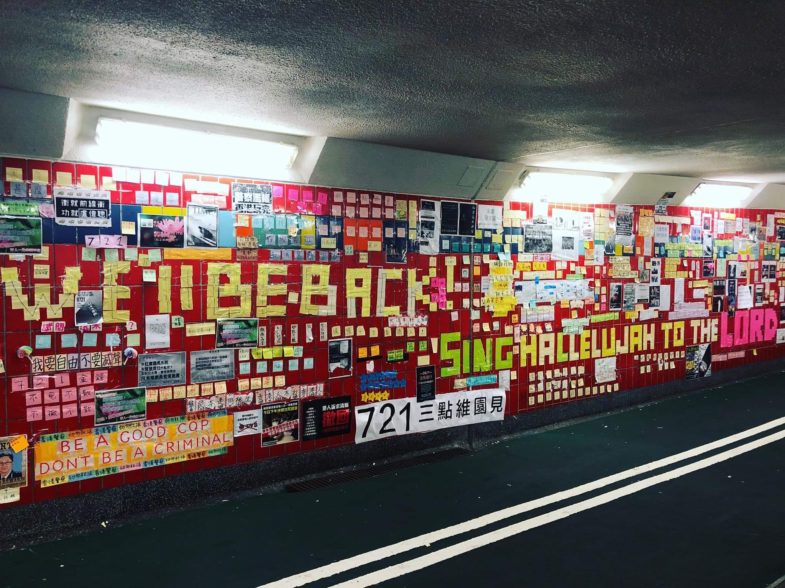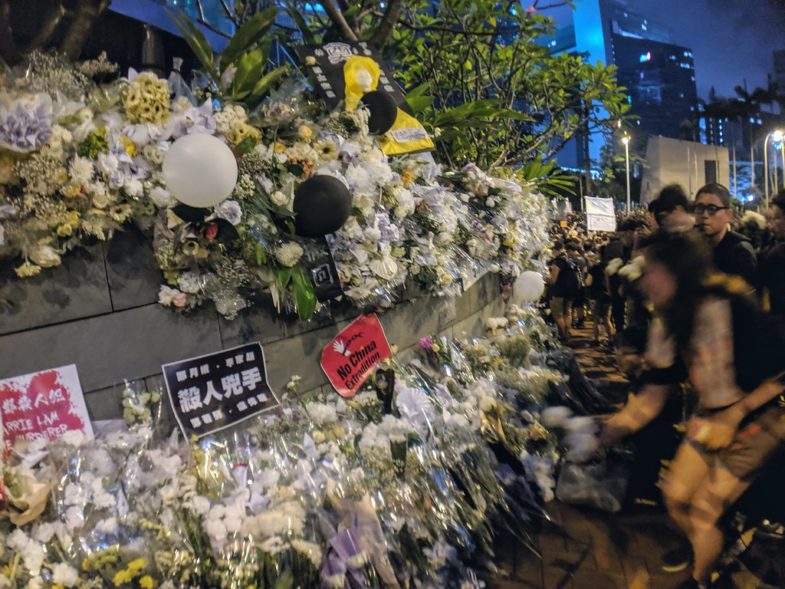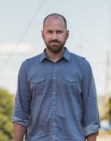Clara Ma [00:00:08] 1997 was a pivotal moment in the history of Hong Kong.
Audio- Chris Patten [00:00:14] Now Hong Kong people are to run Hong Kong. That is the promise and that is the unshakable destiny.
Audio- Jiang Zhemin[00:00:28] Zhai zheli chongsen yiguo liangji gangren jigang wu shi nian bu bian. (I hereby declared that under One Country Two Systems, Hong Kong shall enjoy a high degree of autonomy and remain unchanged for 50 years)
Clara Ma[00:00:40] These words from the last British governor, Chris Patten, and the president of China at the time, Jiang Zemin, reinforce a promise that Hong Kong would retain its own economic, administrative and judiciary systems. And enjoy broad freedoms of religion, expression and assembly until 2047.
Matthew Slaats [00:01:05] This would incorporate Hong Kong into China, but at the same time allow Hong Kong to have some autonomy.
Clara Ma [00:01:14] Though, as with all hope, comes struggle.
Matthew Slaats [00:01:24]I'm Matthew Slats
Clara Ma [00:01:26]I’m Clara Ma
Matthew Slaats [00:01:28] Protests have always been a vital way of making sure China keeps its promise. So vital, in fact, the protest is an important part of what it means to be a Hong Kong
Antony Dapiran [00:01:40] Someone I forget who it is referred to Hong Kong as a Silicon Valley of protest. I think that's that's a fair way to describe it.
Antony Dapiran [00:01:47] My name is Anthony Dapiran. I'm a lawyer and writer and the author of the book City on Fire The Fight for Hong Kong.
Clara Ma[00:01:55] Anthony has lived in Hong Kong for over 20 years. In that time, he has seen and participate in many of the protests.
Antony Dapiran [00:02:09] And they respond by exercising those very rights and freedoms that are potentially being infringed upon by coming to the streets and protesting in the summer of 2019.
Clara Ma [00:02:20] In the summer of 2019, Huge protests erupt in the streets of Hong Kong against an extradition bill, which would have sent people suspect of crimes to mainland China. Many people saw the bill as an encroachment on the existing judiciary system, an explicit challenge to the promise China made that allow Hong Kong to have an independence government system.
Antony Dapiran [00:02:44] And so in that way, the protest becomes not just an act of political expression, but also a a performance of identity by enacting those very values that they see as as as tied up in Hong Kong identity.
Antony Dapiran [00:02:58] So the hope is that, you know, in the end of the day, the vote asking for anything more than what's already written in the law.
Clara Ma [00:03:09] Culture and rituals have become flexible and fluid, giving the protests a sense that many have described as a type of spirituality, Hongkongers who share the same belief of the protests gather together in different forms of everyday activities, such as singing in malls, covering wars in posters, forming human chains, gathering over their lunch hours and even organizing vigils for deceased protesters. Instead of hosting rallies and occupying parts of the city, these activities and events pop up and disperse at a moment's notice and flow fluidly across the city.
Matthew Slaats [00:03:53] Protesters call this idea Be water, a phrase Hong Kong action star Bruce Lee is remembered for saying. That is to flow around obstacles and crashdown when needed.
Anna Cheung[00:04:07] You know, there's a lot of these sporadic events happening everywhere. So people on all different walks of life. You live in a different area. You can participate. So it's a very smart way of conducting this type of event.
Anna Cheung [00:04:22] And instead of every time I need to go to a big rally.
Clara Ma [00:04:27] this is one of the founders of the Hong Kong Democracy Council in the US.
Anna Cheung [00:04:32] So what they can mobilize may be something very small, like when there's a person who'd unfortunate died, they would go to the parking lot or go there to put flowers and to or to a host this, like sing the song in the mall. Right.
Anna Cheung [00:04:52] These things can really easy to organize in a way.
Audio-news clip[00:04:58] This is a very saddening time. But it's good that we can see people getting united and then they all stand together as one.
Matthew Slaats [00:05:14] Today, as new laws are passed, cars continue to protest, yet they live in increasing fear of their ability to voice opposition.
Antony Dapiran [00:05:24] It's this anxiety at Beijing's influence and this anxiety that all of these rights and freedoms of Hong Kong has enjoyed will disappear. And Hong Kong will become just like the rest of China.
Antony Dapiran [00:05:34] That's the biggest fear.
Clara Ma [00:05:36] Though this fear goes beyond the limits being placed on Hong Konger’s freedom of expression.
Winnie [00:05:43] I feel like they have fear, more fear, because we're like kind of like living in white terror nowadays because of fears about police brutality.
Clara Ma [00:05:53] Winnie is the PhD student of the Department of Music at the University of Pennsylvania.
Winnie [00:05:59] I know that some people fear of, for example, not only be arrested, but maybe be disappearing. We are so frustrating that we don't know what we can do as a Hongkonger.
Matthew Slaats [00:06:13] Over the decades, protests have become important moments for creatively overcoming this fear. The protest in 2014, for example, became known as the umbrella movement after the protesters used umbrellas to protect themselves from rain and later, tear gas and governmental surveillance.
Matthew Slaats [00:06:32] These days, protesters do all they can to avoid being identified and detained by the police, covering their faces and disabling cameras with lasers. They also adopt cultural activities and religious rituals on a regular basis as forms of protest.
Clara Ma [00:06:49] With this broad definition of protests, the spirituality of the movement has spread to people from different age groups, economic and religious backgrounds.
Matthew Slaats [00:07:01] Given the various backgrounds of protesters and the fluid ways of participating, how could the spirit of the movement be sustained across millions of protesters for almost a year? Traditional religious rituals play an interesting, important role in this process.
Matthew Slaats [00:07:28] Thousands of people saying this Christian hymn, four hours outside the central government office from the evening of June 11th to the morning of June 12th 2019. This was the night before the second reading of the extradition bill.
Clara Ma [00:07:51] Protesters were filling the streets, demanding their rights. At the same time, rumors about the police taking action and clearing the protests by June 12th have flooded the Internet.
Elton Lo (Voice over) [00:08:07] The atmosphere was very intense. If you look at some footage of the prayer meeting, there were riot police standing around the participants at a prayer meeting.
Matthew Slaats [00:08:14] This is Elton Lo, the organizer of the prayer meeting.
Elton Lo (Voice over) [00:08:18] It was a very tense moment. There were about two thousand people at the prayer meeting at that moment. Everyone was very nervous and did not know what would happen in the next minute.
Clara Ma [00:08:27] At this moment, Elton was torn between the growing tensions of the protests and the spiritual needs of the group.
Elton Lo (Voice over) [00:08:35]
Should I end the prayer meeting and make sure that everyone could go home safely? But I also tended to think of our activity as a religious, spiritual activity. At that moment, I decided to invite the crowd to sing that song, which continued for the whole night. First, people were nervous and in fear, but gradually their emotion got released.
Elton Lo (Voice over) [00:09:10] People even sang in front of the rifles. And luckily, no clashes happened that night. I felt that we had a rather peaceful evening, which was originally very tense.
Matthew Slaats [00:09:33] Since the religious meeting was the only event that was permitted outside of the government office, it became a refuge for the protesters. A moment to rest emotionally, physically, spiritually.
Clara Ma [00:09:47] While the singing began in a group of Christians, It quickly spread out to protests being dumped by protesters and animating the community.
Clara Ma [00:09:59] This is Professor Ying Fuk-Tsang, the former director of the Divinity School at the Chinese University of Hong Kong.
Ying Fuk-Tsang (voice over) [00:10:14] I think that the peaceful quality of the melody and the atmosphere that was brought by the Christian has a special calming effect. As we may know, The atmosphere was very tense that night
Ying Fuk-Tsang (voice over) [00:10:29] When Protesters and police were confronting each other in the front line, sometimes the singing helped to calm down the intense atmosphere.
Ying Fuk-Tsang (voice over) [00:10:37] So surprisingly, the hymn almost became a hymn of protests from June to July 2020.
Elton Lo (Voice over) [00:10: 45] When Christians are singing hymns as a group, We reflect on what we believe in and who we rely on. I think these are the meetings of singing hymns. When I looked back to this moment later, singing hymns was an active response to God.
Elton Lo (Voice over) [00:10:59] When we sing Hallelujah to the Lord, it is a way of claiming we are only loyal to God rather than the political authority on Earth. So when we use a hymn to praise God, it also reminded us that the authority on Earth is not the one that we are loyal to.
Clara Ma [00:11:15] This is what's interesting about singing this hymn. It uses a religious scattering, a public right defined by Hong Kong law to question the authority that the government has over Hong Kong.
Ying Fuk-Tsang (voice over) [00:11:28] It is mainly a form of praising. It means to praise God. But of course, if we go to the Bible, it mentions that this particular hand was written in environments where people were oppressed. At that moment of struggle, one praises God who will make the final decision and be the king. So I guess if we look at it this way to him was not chosen randomly.
Clara Ma [00:11:49] Protesters also adopt the religious significance of singing hymns in a public space to demonstrate that they are sharing the same identity.
Ying Fuk-Tsang (voice over) [00:12:00] For Christians for those who are actively participating in the protest, they emphasize they are not only a member of heaven, but also a citizen on earth. So one should express their concern about the society.
Clara Ma [00:12:13] To Jeffrey Tsoi, a Hongkonger currently living in Washington, D.C., the hymn has other meanings.
Jeffrey Tsoi[00:12:26] As this movement unites Hongkongers, different Hongkongers are allowed or feel welcome to bring their daily lives, their personal beliefs into the movement.
Jeffrey Tsoi [00:12:37] And so I think the fact that we hear Christian songs and their movements is a manifestation of the diversity of Hong Kong democracy struggles because people feel like it's not only a political struggle, you know, it's it's about about their lives.
Matthew Slaats [00:12:59] Jeffrey sees a growing connection between religion and the protests. While once an individual's belief would have been private. It now becomes public, an expression of the person's commitment to the protests and the community.
Jeffrey Tsoi [00:13:14] So in the very beginning of the protests, I think there are some scenes where the Christians are very tough and very devoted to the movement in their own ways. They are not violence.
Jeffrey Tsoi [00:13:33] But, you know, they are very pious, I would say.
Jeffrey Tsoi [00:13:40] And then in their own way, they contribute to the movement. Right. They sit there and they sing for hours.
Jeffrey Tsoi [00:13:51] And any Hong Kong feel like that is a powerful thing, that that might have had an impact on the police, that might have an impact on the government, though ultimately the police might still beat people up or the government might still suppress the protest.
Jeffrey Tsoi [00:14:15] Hongkongers are moved by some of these Christian beliefs and practices.
Matthew Slaats [00:14:27] Another important moment took place on June 16, 2019
Audio – news clip [00:14:31] Thirty five year old man surnamed Lungu, who fell from upon a height from a podium at Pacific Place Mall last night. Finally here, we've see demonstrators clad in black passing basically a funeral scene.
Matthew Slaats [00:14:52] One of the people in the crowd was Lau. A 28 year old protester who came with her friends to pay her respects upon hearing the news.
Lau (voice over) [00:15:00] Everyone was wearing black and many of them carried flowers white paper flowers. Everyone was in grief, although they were shutting out their demand loudly throughout the protest, the crowd became quiet when they passed by the Pacific Place.
Lau (voice over) [00:15:24] People put down flowers, observed a moment of silence, or burnt joss sticks for Leung
Matthew Slaats [00:15:36] Some people brought flowers. Others burned joysticks. These are both Christian and traditional Chinese rituals for the deceased. Yet at a time of grief, people came together as a community in ways that cross boundaries and reinforced the diversity of the movement. Religion. And protests were mixing.
Ting GUO [00:15:54] You see different elements you see with Chrysantheum, white flowers, various white flowers, incense, burning, Buddhist chanting.
Clara Ma [00:16:04] This is Guo Ting, a professor of humanities and religious studies at the University of Hong Kong.
Ting GUO [00:16:16] you have things you would observe at a Daoist funeral in Hong Kong. At the same time, there's also very clear Catholic elements as well. The candles, for instance, the candles with angels, the candles with Mary. Posters as well, about "Jesus love you," "Please stop the violence," "Police rest in peace"
[00:16:33] But they don't you don't feel any conflict, any conflict of interest or anything that's kind of unharmonious about the vast diversity of these elements of that funeral of almost a procession.
Clara Ma [00:16:50] This kind of public vigil developed into a regular event in the course of protests.
Clara Ma [00:16:56] Vigils for Leung, and other deceased protesters took place on a different scale in various parts of the city by having everyone commemorates the deceased in their own way publicly, which emphasized the flexibility of the Be Water strategy. These activities reinforce a sense of community among the participants.
Ting GUO [00:17:16] They are kind of community rituals, so that also give Hongkongers, the people who are involved, that also give them a sense of belonging identity as people can come together. I think that's very important, especially, for instance, last year when most people would feel depressed, even by what was happening in a form of a very formal religious ritual that symbolizes something very formal, very serious, very solemn, very sad, even very tragic. So that gives people courage as well.
Ting GUO [00:17:51] That gives the community that kind of gives the community a blessing.
Matthew Slaats[00:17:55] Even though protesters gradually disappeared from the streets due to the COVID pandemic and the increased risk of getting arrested, many of them still gather at these vigils every month.
Lau (voice over) [00:18:10] The activities provide an opportunity for us to give comfort to each other. Everyone can support each other. This instance was indeed tragedies. But participants may receive some comfort in these occasions. My sister also reminds me that the activities strengthened one's determination in continuing the protests by remembering the deceased protesters as if you are continuing the fight for them.
Jeffrey Tsoi [00:18:51] There is, I guess, a spiritual aspect to it. I don't mean like a religious spiritual aspect, but the spirit of the movement is penetrated in these events, right? It’s manifested or it's amplified through these nontraditional methods
Matthew Slaats [00:19:23] As the government continues to tighten freedoms, Hong Kong has once again have tapped into their creativity to be visible in new ways. King, a designer and organizer, noted how the protests are evolving.
King [00:19:34] I mean, last year, everybody said be water. And that because of the newly-passed national security law and then defend if you say you water, that there are some kind of materials with the water. I mean, water is very physical. And now people say the air and the air you could even use to trade to everywhere. And then the form of air you see even more versatile.
King [00:20:11] So I think this is a very good metaphor for the coming movement.
Music
Clara Ma [00:20:29] Without these visible public riches, we wonder about the future of the protests. How would the spirit of the protests and the community it has created continue?
Matthew Slaats [00:20:42] We can only hope and see.
Clara Ma [00:20:55] The spirituality of protest was written research and edited by us Clara Ma,
Matthew Slaats [00:21:04] Matthew Slaats, the project was done with the support of the Race, Religion and Democracy Lab at the University of Virginia. Led by Martin Halvorson-Taylor and Kurtis Schaefer, Emily Gadek produced the piece and provided their keen guidance.
Matthew Slaats [00:21:17] Ashley Dufffalo made everything to tick.
Clara Ma [00:21:22] Thanks to the many voices that provide important insights into all that has been taking place in Hong Kong. Professor Anna Cheung. Jeffrey Tsoi. Lau, Winnie, Anthony Dapiran. Professor Ting Guo. Professor Fuk-Tsang Ying. And Professor King-Chung SIU. Voice overs were provided by Jinchao Zhao, Apollo Young, and David Chen.
Matthew Slaats [00:21:43] The music was by Shane Ivers. Raise the umbrella composed by Lo Hiu-pan and sang by a group of local pop singers.
Clara Ma [00:21:50] Thanks to the people of Hong Kong for continuing to demand their rights and be an inspiration for us all.








